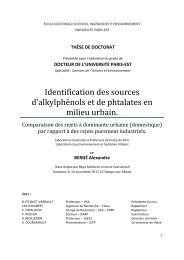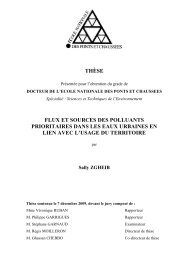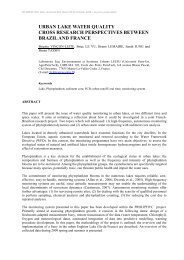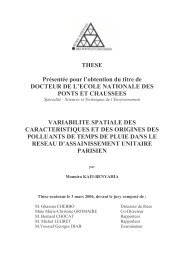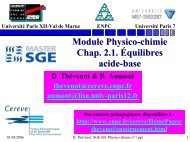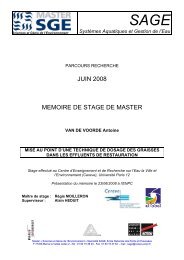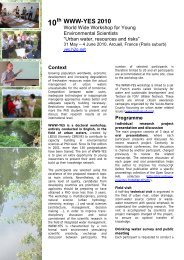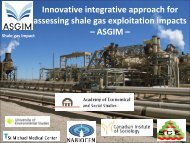Removal of pharmaceuticals during river bank filtration - LEESU
Removal of pharmaceuticals during river bank filtration - LEESU
Removal of pharmaceuticals during river bank filtration - LEESU
You also want an ePaper? Increase the reach of your titles
YUMPU automatically turns print PDFs into web optimized ePapers that Google loves.
II- Overview <strong>of</strong> previous studiesAs <strong>river</strong> <strong>bank</strong> <strong>filtration</strong> is not a new research topic, it seemed important to me to do somereading <strong>of</strong> previous studies in order to acquire a general understanding on the subject.The detail <strong>of</strong> the overview is given in Appendix 1.1) Subject <strong>of</strong> the studiesThere is a large variety <strong>of</strong> studies on the theme <strong>of</strong> <strong>river</strong> <strong>bank</strong> <strong>filtration</strong>. Some describe thegeneral results obtained for a broad range <strong>of</strong> pollutants; others focus on the elimination <strong>of</strong> agroup <strong>of</strong> molecules <strong>during</strong> on-site or lab-scale experiments. Oxic or aerobic conditions andtheir influence on the removal efficiency have been investigated. For the most part, theresearch consisted <strong>of</strong> a series <strong>of</strong> observations on the molecules behavior <strong>during</strong> soil passage.2) Investigated chemicalsSome works expose the results obtained for all OMPs found on the sites <strong>of</strong> the experiments,others focus on some groups <strong>of</strong> chemicals such as antibiotics, flame retardants, or pesticides.The distinction between bulk organic matter and trace organic compounds is done in somecases.3) Experimental set-upsEach study provides experimental results to confirm or contradict theoretical hypothesis anddraw conclusions. Some experiments are done directly on the field and consist <strong>of</strong> a series <strong>of</strong>measurements at different places. Others consist <strong>of</strong> the study <strong>of</strong> lab-scale or pilot-scale sandcolumns reproducing the <strong>river</strong> bed. These artificial set-ups enable a wider range <strong>of</strong>measurements and tests while having the possibility to change redox, aerobic or temperatureconditions in order to have a better understanding <strong>of</strong> the mechanisms responsible for theremoval. The columns are <strong>of</strong>ten filled with artificial sand because it is easier to manipulateand more ―universal‖ than some natural ground samples. Then the columns are fed with waterspiked with the investigated compounds.4) Analytical methodsBulk organic matter is quantified with DOC (Dissolved Organic Carbon) or TOC (TotalOrganic Carbon) measurements. UV 254 measurements can also quantify and characterize theorganic content while ATP tests can assess the biological activity. More specificmeasurements such as chromatography and mass spectroscopy are needed to characterize thetrace organic compounds. The adsorption capacity <strong>of</strong> the ground can be tested with batchexperiments. Retardation factors can then be calculated.5) ResultsRiver <strong>bank</strong> <strong>filtration</strong> is a reliable cleaning process regarding organic micro pollutants as longas the residence time and travel path are long enough. However, some compounds such asSulfamethoxazole are persistent and need other barriers to be totally eliminated. I gathered the23


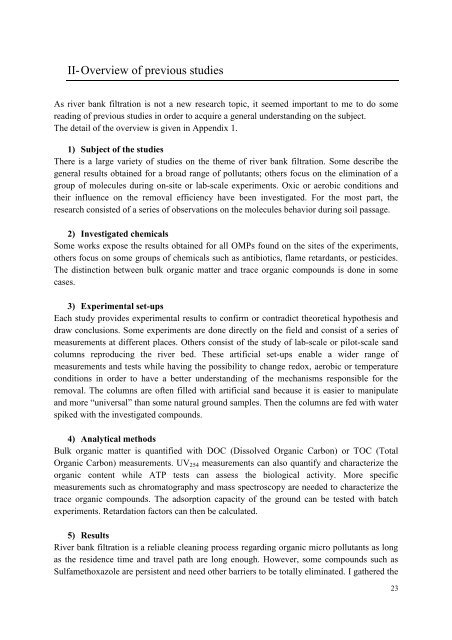

![[pastel-00730831, v1] Incidence des pratiques d'entretien ... - LEESU](https://img.yumpu.com/50938896/1/184x260/pastel-00730831-v1-incidence-des-pratiques-dentretien-leesu.jpg?quality=85)

